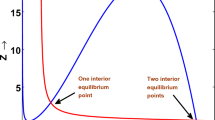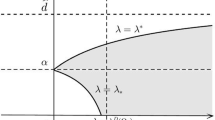Abstract
The aim of this paper is to investigate the evolution of body size of population subject to dispersal and advection. For this purpose, we consider a reaction–diffusion system for competing species with hostile boundary conditions, which models population dynamics in advective environments. First, with the methods of adaptive dynamics, we discuss the stability of evolutionary singular strategy; specifically, evolutionary conditions for continuously stable strategy and evolutionary branching are obtained. Second, by theoretical analysis and numerical simulations, we investigate the influence of dispersal and advection on the evolution trend of body size and high-level polymorphism. Our results show that in environments without advection, the result of evolution mainly depends on competition coefficients, intrinsic growth rates and biological dispersal. In particular, the evolution of the body size will tend to the slow disperser with the increase in the dispersal rate if regardless of the influence of body size on competitiveness and growth rate. But there will be different results in advective environments, the increasing dispersal rate may lead to the evolution of the body size toward a intermediate level. A small or a moderate dispersal rate is likely to stimulate the emergence of evolutionary branching. In addition, our results predict that for hostile boundary conditions, advection can promote evolutionary stability, which prevent the emergence of evolutionary branching.





Similar content being viewed by others
Data Availability
Data and materials sharing is not applicable to this article as no datasets were generated or analyzed during the current study.
References
Darwin, C.: On the Origin of Species by Means of Natural Selection, or the Preservation of Favoured Races in the Struggle for Life. Bantam Books (1993)
Cosner, C., Lou, Y.: Does movement toward better environments always benefit a population? J. Math. Anal. Appl. 277, 489–503 (2003)
Lutscher, F., Lewis, M.A., McCauley, E.: Effects of heterogeneity on spread and persistence in rivers. Bull. Math. Biol. 68, 2129–2160 (2006)
Clobert, J., Danchin, E., Dhondt, A.A., Nichols, J.D.: Dispersal. Oxford University Press, Oxford (2001)
Cosner, C.: A dynamic model for the ideal-free distribution as a partial differential equation. Theor. Popul. Biol. 67, 101–108 (2005)
Hambrock, R., Lou, Y.: The evolution of conditional dispersal strategy in spatially heterogeneous habitats. Bull. Math. Biol. 71, 1793–1817 (2009)
Cantrell, R.S., Cosner, C., Lou, Y.: Movement towards better environments and the evolution of rapid diffusion. Math. Biosci. 240, 199–214 (2006)
Yang, J., Yuan, S., Zhang, T.: Complex dynamics of a predator–prey system with herd and schooling behavior: with or without delay and diffusion. Nonlinear Dyn. 104, 1709–1735 (2021)
Du, Y.H., Hsu, S.B.: On a nonlocal reaction–diffusion problem arising from the modeling of phytoplankton growth. SIAM. J. Math. Anal. 42, 1305–1333 (2010)
Wang, C., Yuan, S., Wang, H.: Spatiotemporal patterns of a diffusive prey–predator model with spatial memory and pregnancy period in an intimidatory environment. J. Math. Biol. (2022). https://doi.org/10.1007/s00285-022-01716-4
Cantrell, R.S., Cosner, C.: Spatial Ecology via Reaction–Diffusion Equations. Series in Mathematical and Computational Biology, Wiley, New York (2003)
Cantrell, R.S., Cosner, C., DeAngelis, D.L., Padr’on, V.: The ideal free distribution as an evolutionarily stable strategy. J. Biol. Dyn. 1, 249–271 (2007)
Lam, K.Y., Lou, Y.: Evolutionarily stable and convergent stable strategies in reaction–diffusion models for conditional dispersal. Bull. Math. Biol. 76, 261–291 (2014)
Hastings, A.: Can spatial variation alone lead to selection for dispersal. Theor. Popul. Biol. 24, 244–251 (1983)
Cantrell, R.S., Cosner, C., Lewis, M.A., Lou, Y.: Evolution of dispersal in spatial population models with multiple timescales. J. Math. Biol. 80, 3–37 (2020)
Choi, W., Baek, S., Ahn, I.: Intraguild predation with evolutionary dispersal in a spatially heterogeneous environment. J. Math. Biol. 78, 2141–2169 (2019)
Muller, K.: The colonization cycle of freshwater insects. Oecologica 53, 202–207 (1982)
Speirs, D.C., Gurney, W.S.C.: Population persistence in rivers and estuaries. Ecology 82, 1219–1237 (2001)
Lam, K.Y., Lou, Y.: Evolution of conditional dispersal: evolutionarily stable strategies in spatial models. J. Math. Biol. 68, 851–877 (2013)
Lou, Y., Lutscher, F.: Evolution of dispersal in open advective environments. J. Math. Biol. 69, 1319–1342 (2014)
Vasilyeva, O., Lutscher, F.: Competition of three species in an advective environment. Nonlinear Anal. Real World Appl. 13, 1730–1748 (2012)
Vasilyeva, O., Lutscher, F.: Competition in advective environments. Bull. Math. Biol. 74, 2935–2958 (2012)
Chen, X., Hambrock, R., Lou, Y.: Evolution of conditional dispersal, a reaction–diffusion–advection model. J. Math. Biol. 57, 361–386 (2008)
Demetrius, L.: Directionality theory and the evolution of body size. Proc. Biol. 267, 2385–2391 (2000)
Zu, J., Mimura, M., Takeuchi, Y.: Adaptive evolution of foraging-related traits in a predator–prey community. J. Theor. Biol. 268, 14–29 (2011)
Meng, X., Liu, R., Zhang, T.: Adaptive dynamics for a non-autonomous Lotka–Volterra model with size-selective disturbance. Nonlinear Anal. Real World Appl. 16, 202–213 (2014)
Metz, J., Nisbet, R., Geritz, S.: How should we define fitness for general ecological scenarios. Trends. Ecol. Evol. 76, 198–202 (1992)
Dieckmann, U., Law, R.: The dynamical theory of coevolution: a derivation from stochastic ecological processes. J. Math. Biol. 34, 579–612 (1996)
Diekmann, O.: A beginner’s guide to adaptive dynamics. Banach. Center. Publ. 63, 47–86 (2003)
Geritz, S.A.H., Gyllenberg, M.: The Mathematical Theory of Adaptive Dynamics. Cambridge University Press, Cambridge (2008)
Geritz, S.A.H., Kisdi, E., Meszena, G., Metz, J.A.J.: Evolutionarily singular strategies and the adaptive growth and branching of the evolutionary tree. Evol. Ecol. 12, 35–57 (1998)
Kisdi, E.: Evolutionary branching under asymmetric competition. J. Theor. Biol. 197, 149–162 (1999)
Ferriere, R., Rinaldi Dercole, F.S.: Ecological bistability and evolutionary reversals under asymmetrical competition. Evolution 56, 1081–1090 (2002)
Ma, J., Levin, S.: Dynamics and management of stage-structured fish stocks. Bull. Math. Biol. 68, 1111–1123 (2006)
Svennungsen, T., Kisdi, A.: Evolutionary branching of virulence in a single-infection model. J. Theor. Biol. 257, 408–418 (2009)
Zu, J., Wang, K., Mimura, M.: Evolutionary branching and evolutionarily stable coexistence of predator species: critical function analysis. Math. Biosci. 231, 210–224 (2011)
Zhao, S., Yuan, S., Wang, H.: Adaptive dynamics of a stoichiometric phosphorus–algae–zooplankton model with environmental fluctuations. J. Nonlinear Sci. (2022). https://doi.org/10.1007/s00332-022-09794-w
Hsu, S.B., Hubbell, S., Waltman, P.A.: Mathematical theory for single-nutrient competition in cocontinuous cultures of micro-organisms. SIAM. J. Math. Appl. 32, 366–383 (1997)
Kisdi, E.: Evolutionary branching under asymmetric competition. J. Theor. Biol. 197, 149–162 (1999)
Hutson, V., Martinez, S., Mischaikow, K., Vickers, G.T.: The evolution of dispersal. J. Math. Biol. 47, 483–517 (2003)
Tilman, D., Lehman, C.L.: Human-caused environmental change: impacts on plant diversity and evolution. P. Natl. Acad. Sci. USA 98, 5433–5440 (2001)
Jansen, V., Mulder, G.: Evolving biodiversity. Ecol. Lett. 2, 379–386 (1999)
Foster, J.B.: The evolution of mammals in islands. Nature 202, 234–235 (1964)
Matsuda, H., Abrams, P.A.: Runaway evolution to self-extinction under asymmetrical competition. Evolution 48, 1764–1772 (1994)
Dockery, J., Hutson, V., Mischaikow, K., Pernarowski, M.: The evolution of slow dispersal rates: a reaction–diffusion model. J. Math. Biol. 37, 61–83 (1998)
Acknowledgements
This work is supported by the National Natural Science Foundation of China (No. 12271308).
Author information
Authors and Affiliations
Corresponding author
Ethics declarations
Conflict of interest
The authors declare that they have no conflict of interest.
Additional information
Publisher's Note
Springer Nature remains neutral with regard to jurisdictional claims in published maps and institutional affiliations.
Appendices
Appendix A
The following differential system is constructed about eigenvalue
\((i=1,2)\). It is not difficult to verify that if \(q^{2}(s_{i})-4d(s_{i})\lambda (s_{i})\ge 0\), then \(N_{i}=0\). If \(q^{2}(s_{i})-4d(s_{i})\lambda (s_{i})<0\),
According to \(N_{i}(0)=N_{i}(L)=0\), we can get \(C_{1}=0\),
where k is positive integer. Therefore, the dominant eigenvalue of the advection–diffusion operator satisfies
Appendix B: Proof of Proposition 2
Evolutionary singular strategy is the solution of the following equation
Let
then
The evolutionary singular strategy can be regarded as the solution of the following equation equivalently,
We discuss the following four situations, respectively.
-
(i)
\(\kappa _{1}<1\), \(\kappa _{2}<1\) is equivalent to \(\phi _{1}(0)<0\), \({\tilde{s}}_{2}<{\tilde{s}}_{1}\). This implies \(\phi _{1}({\tilde{s}}_{2})-\phi _{2}({\tilde{s}}_{2})<0\), \(\phi _{1}({\tilde{s}}_{1})-\phi _{2}({\tilde{s}}_{1})>0\), due to zero point theorem, there is at least one singular point \(s^{*}\in (\tilde{s_{2}},\tilde{s_{1}})\), and \(\phi _{1}(s^{*})=\phi _{2}(s^{*})<0\). And it is not difficult to verify that there is no evolutionary singular strategy outside \((\tilde{s_{2}},\tilde{s_{1}})\).
-
(ii)
\(\kappa _{1}<1\), \(\kappa _{2}>1\) is equivalent to \(\phi _{1}(0)<0\), \({\tilde{s}}_{2}>{\tilde{s}}_{1}\). This means \(\phi _{1}({\tilde{s}}_{2})-\phi _{2}({\tilde{s}}_{2})>0\), \(\phi _{1}({\tilde{s}}_{1})-\phi _{2}({\tilde{s}}_{1})<0\), in this case there is at least one singular point \(s^{*}\in (\tilde{s_{1}},\tilde{s_{2}})\), and \(\phi _{1}(s^{*})=\phi _{2}(s^{*})>0\). And there is no evolutionary singular strategy outside \((\tilde{s_{1}},\tilde{s_{2}})\).
-
(iii)
\(\kappa _{1}>1\) implies \(\phi _{1}(0)>0\), \(0<\kappa _{3}<1\) means \(0<\phi _{1}(0)<\phi _{2}(0)\). Considering \(\phi _{1}({\tilde{s}}_{2})-\phi _{2}({\tilde{s}}_{2})>0\), there is at least one singular point \(s^{*}\in (0,\tilde{s_{2}})\), and \(\phi _{1}(s^{*})=\phi _{2}(s^{*})>0\). If \(s>\tilde{s_{2}}\), \(\varPhi _{1}(s)\varPhi _{1}(s)<0\), thus, there is no evolutionary singular strategy in \((\tilde{s_{2}},\infty )\).
-
(iv)
If \(\kappa _{1}>1\) and \(\kappa _{3}>1\), the singular points may not exist; if it exists, we can get \(s^{*}\in (0,\tilde{s_{2}})\), and \(\phi _{1}(s^{*})=\phi _{2}(s^{*})>0\).
The proof of the proposition is completed.
Appendix C: Proof of Proposition 3
Evolutionary singular strategies are the points that satisfy the following equation
Although we do not have the explicit expression of evolutionary singular strategies, we can calculate the derivative of \(s^{*}\) with respect to \(p_{d}\) indirectly by implicit differential equation. It is given by
For the convergence stable strategy \(s^{*}\), \(\frac{\partial D(s^{*})}{\partial s^{*}}<0\), according to the proof of Proposition 2, if \(\kappa _{i}<1\ (i=1,2)\), then the numerator of Eq. (32) is negative. Thus, the derivative of \(s^{*}\) with respect to \(p_{d}\) is positive. Otherwise, the derivative of \(s^{*}\) with respect to \(p_{d}\) is negative. The proof is complete.
Appendix D: Proof of Proposition 4
By calculation, we can obtain
If condition (i) or condition (ii) of Proposition 4 holds, then \(\frac{\textrm{d} s^{*}}{\textrm{d} p_{d}}>0\), and if condition (iii) or condition (iv) of Proposition 4 holds, then \(\frac{d s^{*}}{d p_{d}}<0\). The proof is completed.
Rights and permissions
Springer Nature or its licensor (e.g. a society or other partner) holds exclusive rights to this article under a publishing agreement with the author(s) or other rightsholder(s); author self-archiving of the accepted manuscript version of this article is solely governed by the terms of such publishing agreement and applicable law.
About this article
Cite this article
Zhang, W., Meng, X. & Qi, H. Evolutionary dynamics of body size subject to dispersal and advection. Nonlinear Dyn 111, 11655–11670 (2023). https://doi.org/10.1007/s11071-023-08415-9
Received:
Accepted:
Published:
Issue Date:
DOI: https://doi.org/10.1007/s11071-023-08415-9




